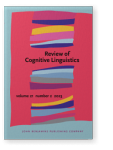Vol. 21:2 (2023) ► pp.515–541
The semantic mapping of the German spatial preposition JENSEITS
The present study aims to investigate the semantic value of the German spatial preposition jenseits (‘beyond’). It is argued that our conceptualization of the spatial-physical world and how we interact with objects in our environment transforms a prepositions’ primary meaning into domains of meaning that are tied to time or social interactions. While the study of the semantic structure of English prepositions has received attention, German prepositions, particularly less frequently used ones such as hinter (‘behind’) or jenseits, present a gap in research. It is attempted to show that the different senses of jenseits form a semantic network in which meaning extensions of the spatial, primary sense of jenseits are motivated by varying construal patterns imposed upon an observed scene. The description of the semantic structure of jenseits also draws on previous studies on its English counterpart, beyond (Boers, 1996; Lindstromberg, 2010). Based on the sample collected for the purpose of this study, this paper analyzes 1000 occurrences of the preposition jenseits in the DWDS-subcorpus Die Zeit. The analysis shows that a high frequency of the occurrences found in the sample constitute non-spatial meanings of jenseits and thus encode a configuration between objects in more abstract domains. Furthermore, the notion of metaphorical mapping is used to explain the conceptualization and metaphorical transfer of spatial jenseits to abstract domains of human experience.
Article outline
- 1.Introduction
- 1.1CL: spatial prepositions
- 1.2Conceptualization of the TR-LM relationship
- 1.3Sense extensions of prepositions: radial networks
- 2. Jenseits in other literature
- 3.Methodology
- 4.The various senses of Jenseits
- 4.1The primary sense: On the other side of & at a greater distance away from something
- 4.2The surpassing of a bounded category sense
- 4.3The inaccessibility sense
- 4.4The temporal sense
- 4.5The in addition to sense
- 4.6The semantic structure of jenseits
- 5.The various construals of jenseits
- 6.Conclusion
-
List of References
